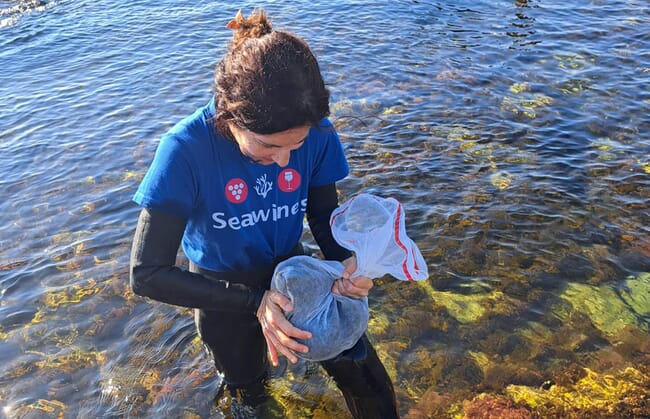
© SEAWINES
While more research is needed to corroborate what has been observed in field testing, the SEAWINES project – led by the University of the Basque Country (UPV/EHU) and the Andalusian Institute of Agricultural and Fisheries Research and Training (IFAPA) – is optimistic about the future of the seaweed extract from Rugulopteryx okamurae to reduce or replace the most common chemical treatments in viticulture (the cultivation and harvesting of grapes).
The European Commission has set itself the target of a 50 percent reduction in pesticides used in agriculture by 2030. These products are also known to be particularly abundant in viticulture given the frequency of infections by organisms as diverse as downy mildew and powdery mildew, both of which are caused by fungi. With the aim of “seeking a strategic, ecological alternative to combat these two fungi, a year ago we launched the SEAWINES project,” said Iratxe Zarraonaindia, research associate at UPV/EHU, in a press release.
In the SEAWINES project, the biostimulant and fungicidal effects of two algae are being explored: Ulva ohnoiand the invasive seaweed Rugulopteryx okamurae, which originates from Asia and is widespread along the Mediterranean coast. According to Zarraonaindia, the protective effect of the latter has not been analysed to date, but numerous studies are underway to examine its uses or applications.
“Our commitment has been to test the capacity of some extracts of these algae to activate the defence mechanisms of plants as an alternative to pesticides, so that the plant is stronger when attacked by a pathogenic fungus,” specified Zarraonaindia.
Firstly, the study was carried out in greenhouses under controlled conditions. The researchers treated grapevines of the Tempranillo variety in the greenhouses of Neiker, at the Basque Institute of Agricultural Research and Development, by impregnating their leaves with various seaweed extracts from Ulva ohnoi and Rugulopteryx okamurae.
Following the treatments, leaf samples were taken and analyses was carried out to analyse the effect of each treatment. “The most positive results were obtained with one of the extracts produced from the invasive alga Rugulopteryx okamurae,” explained Zarraonaindia. “After treatment with this extract, we saw how there was an increase in the expression of resistant genes and in the activity of antioxidant enzymes in the plant, among other things. In the microbiota on the leaf surface, we also saw that some fungi that help the plant in biological control are more abundant on the plants that received the Rugulopteryx extract.”
Zarraonaindia was not surprised by the results: “Ultimately, as it is an invasive species, it is to be expected that it has capabilities or qualities that help it to thrive and also to displace other species so effectively.”
Confirmation of results under real conditions
SEAWINES is a three-year project and to obtain as complete a measurement as possible of the potential of the invasive algae, work has already begun in field experiments to confirm the results obtained under greenhouse conditions.
“We will be testing the algae extracts in vineyards in Jerez and La Rioja under local conditions,” Zarraonaindia added. “We will also be monitoring the impact across the stages of winemaking – in other words, to see the effect these treatments have on grape and wine quality, as well as on the biostimulation and antifungal effect they produce.”
She concluded: “We are looking forward to seeing how useful the Rugulopteryx algae may be. It would be great to be able to remove it from the environment and use it to strengthen viticulture; that would be a good example of the circular economy.”
The original research paper can be read in full on the Frontiers website.


